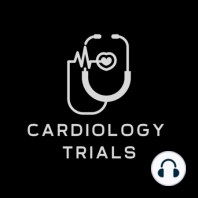37 min listen
Review of the CURRENT-OASIS 7 trial
ratings:
Length:
8 minutes
Released:
Apr 18, 2024
Format:
Podcast episode
Description
N Engl J Med 2010;363:930-942Background By 2010, dual antiplatelet therapy had been established as beneficial during and after percutaneous coronary intervention for acute coronary syndromes. Optimal dosing however remained unknown. This included the best loading dose of clopidogrel and optimal dose of aspirin.Cardiology Trial’s Substack is a reader-supported publication. To receive new posts and support our work, consider becoming a free or paid subscriber.The Clopidogrel and Aspirin Optimal Dose Usage to Reduce Recurrent Events−Seventh Organization to Assess Strategies in Ischemic Syndromes (CURRENT–OASIS 7) trial was designed to determine whether a doubling of the loading and initial maintenance doses of clopidogrel is superior to the standard-dose regimen and whether higher-dose aspirin (300 to 325 mg daily) is superior to lower-dose aspirin (75 to 100 mg daily) in patients with acute coronary syndromes referred for an early invasive strategy.Patients Adult patients who presented with a non-ST-segment elevation acute coronary syndrome (ACS) or an ST-segment elevation myocardial infarction. Patients had to have had coronary angiography with a plan to perform PCI within 72 hours. Major exclusion criteria were an increased risk of bleeding or active bleeding and a known allergy to clopidogrel or aspirin. Baseline Characteristics Nearly all patients had angiography. About 68% had PCI and 32% did not have PCI due to lack of significant (≤70%) stenosis. About a quarter of patients had coronary-artery bypass surgery. The average age of patients was 61 years; 27% female sex, and 70% had a diagnosis of unstable angina or NSTEMI. The median time to randomization in patients with unstable angina/NSTEMI was 3.4 days vs 0.6 days in patients with STEMI. About 60% of patients were white, and 22% were Asian. The co-existing cardiac risk factors, such as smoking, hypertension, diabetes and previous MI were similar in all the trial arms, and typical of most trials at the time.Procedures The CURRENT-OASIS 7 trial had 2x2 factorial design. First, comparing in a double-blind fashion, a double dose vs standard dose clopidogrel regimen. In the second component, patients were randomly assigned in an open-labeled fashion to higher- or lower-dose aspirin.Immediately after randomization and before coronary angiography, patients randomly assigned to double-dose clopidogrel received a loading dose of 600 mg on day 1, followed by 150 mg once daily on days 2 through 7. Patients assigned to standard-dose clopidogrel received a 300-mg loading dose on day 1 before angiography, followed by 75 mg once daily on days 2 through 7. On days 8 through 30, both the double-dose and standard-dose groups received 75 mg of clopidogrel once daily.Patients randomly assigned to lower-dose aspirin received 75 to 100 mg daily on days 2 through 30, and those randomly assigned to higher-dose aspirin received 300 to 325 mg daily on days 2 through 30. An initial loading dose of aspirin 300 mg was used in both arms on day 1. Other therapies, such as anti-thrombotics were left to the discretion of the treating doctors. Endpoints The primary endpoint was cardiovascular death, myocardial infarction, or stroke at 30 days. The sample-size calculation estimated an event rate of 11% at 30 days with standard-dose clopidogrel or lower-dose aspirin. That would have led to 14,000 patients to have 90% power to detect a 16% reduction in the primary endpoint. Lower-than expected event rates required an increase in sample size to 25,000 patients. This allowed for an 80% power to detect a 16% reduction in the primary endpoint.Results A primary outcome event occurred in 4.2% of patients in the double-dose clopidogrel group at 30 days, as compared with 4.4% in the standard-dose group (hazard ratio, 0.94, 95% confidence interval [CI], 0.83 to 1.06; P=0.30). The rate of death from any cause did not differ significantly between the double-dose and standard-dose groups (2.3% and 2.4%, respectively;
Released:
Apr 18, 2024
Format:
Podcast episode
Titles in the series (40)
Summary and discussion of CAST and ISIS-3 by Cardiology Trials
